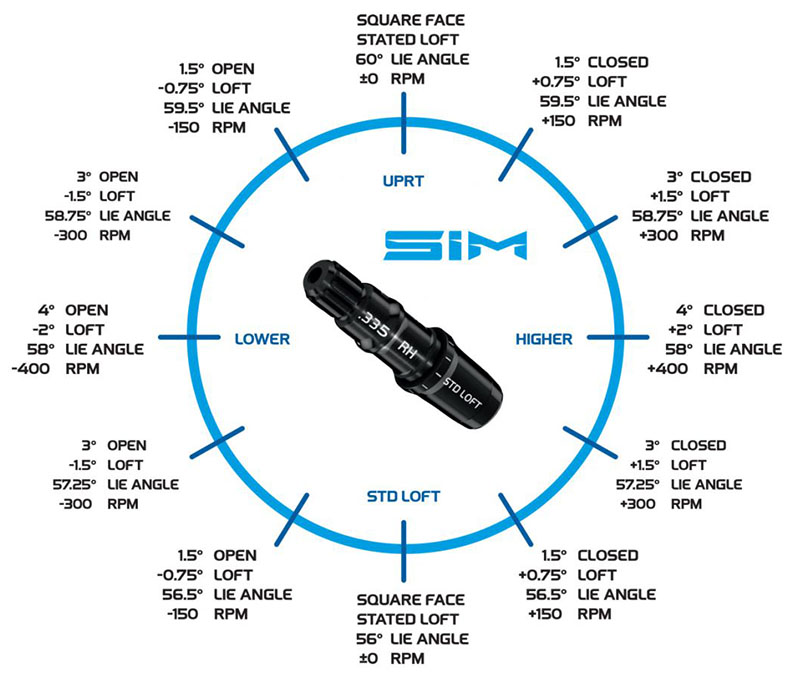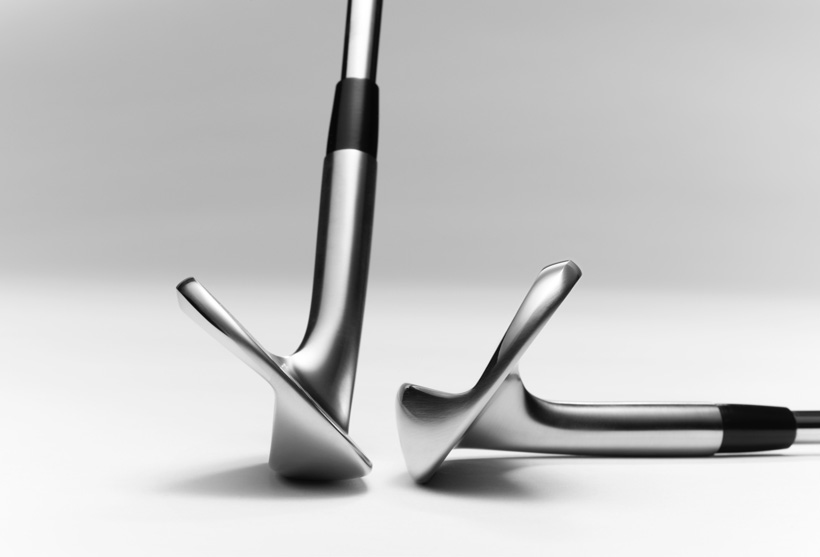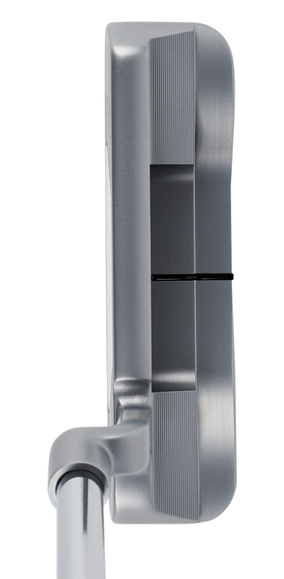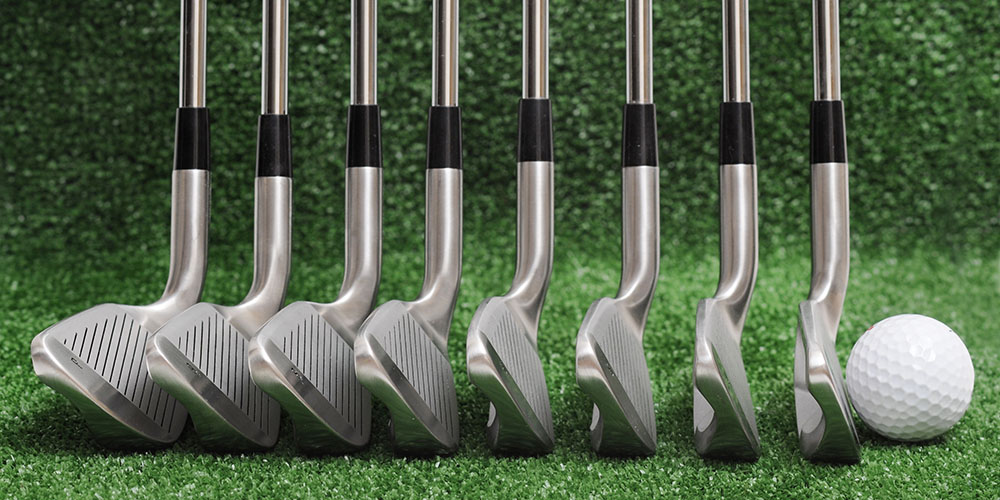Golf Club Lofts | Wedge, Iron, Wood, Driver Degree of Lofts Explained
Golf club lofts play a significant factor in how high you'll launch a ball, how much spin you'll place on the ball, and ultimately how far the ball will travel.
In this guide, we've gathered the golf club specs of various products made by top manufacturers to explain the lofts of all golf clubs.
You can jump ahead to any part of this guide using the following links:
- Golf Club Loft Chart
- Wood Lofts
- Iron Lofts
- Wedge Lofts
- Hybrid Lofts
- Putter Loft
- Golf Clubs' Loft Comparison Table
Golf Club Lofts Chart
We'll explore the lofts of each golf club in more detail below, but here is a chart summarizing each club's loft.
We've included a column for both standard lofted irons and stronger lofted game-improvement style irons (beginner/high handicap clubs). Keep in mind most iron manufacturers make multiple iron sets with lofts between these two extremes for low to mid-handicap golfers.
| Club | Standard Lofts (Tour Level Irons) | Strong Lofts (Game-Improvement Irons) |
| Driver | 9°-12.5° | |
| 3-Wood | 15° | |
| 4-Wood | 17° | |
| 5-Wood | 18°-19° | |
| 7-Wood | 21°-22° | |
| 2-Hybrid | 17°-18° | |
| 3-Hybrid | 19°-20° | |
| 4-Hybrid | 21°-23° | |
| 5-Hybrid | 24°-26° | |
| 2-Iron | 16-19° | |
| 3-Iron | 21° | |
| 4-Iron | 24° | 19° |
| 5-Iron | 27° | 21° |
| 6-Iron | 30° | 25° |
| 7-Iron | 34° | 28° |
| 8-Iron | 38° | 32° |
| 9-Iron | 42° | 38° |
| PW | 46° | 43° |
| GW | 51° | 48° |
| SW | 54°-58° | |
| LW | 58°-64° |
Wood Lofts
Woods typically have lower lofts than their iron and hybrid counterparts. For example, a standard 3-wood has around 15 degrees of loft, while most 3-irons have 19-21 degrees of loft.
Jump ahead to see the lofts of these woods:
Driver Loft | 9 to 12.5 Degrees
With the exception of putters, drivers are the lowest lofted golf clubs. They're also the longest club in the bag, with a standard length of around 45".

TaylorMade SIM2 Driver
The standard loft of most drivers is 9 to 12.5 degrees, though some golfers go to further extremes. Keep in mind that drivers are almost always hit with the ball teed up 1.5 inches or more, allowing good drivers of the ball to hit it at a slightly upward angle resulting in additional "dynamic loft."
Bryson DeChambeau has famously used a Driver with as low as 4.8° of loft, though his positive (upward) angle of attack adds to the dynamic loft at impact.
Golfers with slower swing speeds and golfers with too low of an angle of attack (like those who swing slightly down on the ball with driver) will typically benefit from higher lofted drivers (10.5-12.5°). Faster swinging golfers and those with a positive angle of attack (creating more dynamic loft) are often better suited to drivers on the lower end of the loft spectrum (8-10.5°).
Today, loft on most of the best drivers can be adjusted by 1-3 degrees in a matter of seconds. However, keep in mind that this will also alter how open/closed the clubface is and the lie angle of the clubhead.
Taylormade's SIM drivers, for example, have a loft sleeve on the end of the shaft. This allows you to unscrew the clubhead from the shaft and reattach them together at a different loft.

TaylorMade SIM Loft Sleeve™ Technology - Source TaylorMade
Loft and dynamic loft are highly correlated with spin and trajectory. If you're not hitting the ball high enough or are hitting too low spinning drives, you may want to increase the loft of your driver. Conversely, if you're putting too much spin on the ball even when striking it from the sweet spot or if you're hitting the ball too high, you should consider a lower lofted driver.
3-Wood Loft | 13.5 to 16 Degrees
The standard 3-wood loft is 15 degrees, though you can commonly find them with lofts anywhere from 13.5-16.5 degrees. As we'll cover below, this puts 3-woods around the same loft as a 2-iron.

Cobra RADSPEED 3-Wood
The optimal 3-wood loft will depend on the player and what they're hoping to get from the club.
As a generalization, better players and those looking to maximize distance off the tee usually use lower lofted 3-woods.
Players who struggle to get the ball in the air, especially golfers who most often use their 3-wood off the deck, will be best served with standard or higher lofted options.
Like drivers, it's slowly becoming the standard from manufacturers to make 3-woods with adjustable loft.
5-Wood Loft | 17.5 to 19.5 Degrees
The majority of 5-Woods have 18-19 degrees of loft, but some manufacturers go as low as 17.5 or as high as 19.5 degrees. Depending on the manufacturer and who the clubs are designed for, a 3-iron often has a loft just between a 5-Wood and a 7-Wood.
5-Woods had lost popularity for a while among better golfers who favored low irons and hybrids. Like 5-wood and 7-wood, higher woods had been reserved for shorter hitters who struggled with long irons until a recent resurgence in fairway wood use.
Insights provided by launch monitor data show us that 5-Woods or even 7-Woods can provide better ball flight and spin characteristics for long approach shots even for better golfers.
Many better players also choose between a fairway wood or long iron/hybrid depending on the wind conditions and the dryness of the course on a given day. Higher launching and spinning woods can make sticking fast greens easier than with irons, but these same factors make shots with woods more susceptible to go offline in windy conditions.
7-Wood Loft | 21 to 22.5 Degrees
Most 7-woods have a standard loft of 21 degrees, though we've seen them as high as 22.5 degrees from manufacturers like Cobra.
Like 5-woods, 7-woods can be a suitable replacement for a low iron or hybrid. 7-Woods are more forgiving, easier to hit for many players, and can offer better ball flight characteristics than an iron or hybrid. While they've just begun their comeback among better male golfers, they've long been a staple in beginner's and women's bags.
Dustin Johnson, Adam Scott, Bubba Watson, and Louis Oosthuizen are just a few of the PGA Tour professionals who have recently carried a 7-wood in professional play.
If you hit a 5-wood too close to your 3-wood for optimal yardage gapping, try out a 7-wood.
Other Wood Lofts
In the past, it was common also to see 2-woods and 4-woods.
2-Woods typically have a loft of around 12 degrees.
4-Woods usually have 17 degrees of loft.
While these clubs are rare, Phil Mickelson has recently used a super low lofted 5° driver paired with a 12.5° 2-wood on the PGA Tour.
Iron Lofts

Like woods, the lower the iron number, the lower its loft.
If you're getting back into golf after a long hiatus, you'll notice iron lofts have gotten a lot "stronger" over the years. In other words, many irons, especially those aimed at beginners, have fewer degrees of loft than irons numbered the same in the past.
Modern technology has created the ability to make much more forgiving and higher launching irons. These irons, typically used by beginners and higher handicap golfers, need to have lower lofts to maintain optimal ball flight characteristics.

In the chart above, we compiled iron lofts from some of the best golf club manufacturers' different iron sets.
You'll see some extreme differences between each manufacturers' game improvement irons and their irons designed for the best golfers. For example, Cobra's King RADSPEED 6-iron has a loft of just 24 degrees, while their King Tour 6-iron has 29 degrees.
Other manufacturers like TaylorMade, Callaway, and Mizuno also have extreme differences in lofts between their different offerings.
You probably also noticed from the chart that each manufacturer makes iron sets between the two extremes, with these sets being designed for mid and low handicap golfers.
Jump ahead using any of these links to see the lofts for the following irons:
1-Iron | 14 to 16 Degrees
1-irons don't really exist today, as they shouldn't because practically nobody can hit them effectively.
In the past, however, it was a bit more common to see them.
1-irons typically have lofts between 14 to 16 degrees.
2-Iron | 16 to 19 Degrees
Like 1-irons, 2-irons aren't that commonly used today. Only being allowed 14 clubs in your bag, most golfers will prefer to have a 4th wedge, hybrid, or fairway wood over low irons.
Depending on the manufacturer, modern 2-irons have between 16 to 19 degrees of loft.
Many 2-irons (and many 3 and 4-irons) used today are made specially to be more forgiving, usually having large cavity backs. Many golfers will opt for a "utility" or "rescue" style iron if not using hybrids in place of low irons.
Utility irons, like those from Cobra, even have adjustable lofts.

Cobra Utility Iron With Adjustable Loft
3-Iron Loft | 19 to 21 Degrees
3-Irons are the lowest iron that can be purchased in the majority of iron lineups. Depending on what level of player they're made for, 3-irons have lofts ranging from 19 to 21 degrees.
Again, the vast majority of players today would be better served using a hybrid or fairway wood instead of a 3-iron.
4-Iron Loft | 19 to 24 Degrees
4-Iron is the lowest iron reasonable for the average golfer to consider playing, though still most golfers would be better suited with a hybrid. Today, many iron sets have options of 5-iron through wedges because so many people now prefer a hybrid over a 4-iron.
There starts to be a relatively wide range of lofts when you look at 4-irons. A more standard 4-iron loft is between 21 to 24 degrees of loft, though some game improvement 4-irons will have lofts as low as 19 degrees.
5-Iron | 21 to 27 Degrees
Today's traditional 5-iron lofts are 26 to 27 degrees, though game improvement iron sets can have 5-irons with as low as 21 degrees of loft .
Except for very slow swingers, 5-irons are a staple in nearly every golfer's bag.
6-Iron Loft | 24 to 31 Degrees
6-Irons made for better players will have lofts from 30 to 31 degrees, while 6-irons made for beginners can have lofts as low as 24 degrees.
7-Iron Loft | 28 to 35 Degrees
A more standard loft for a 7-iron is 34 to 35 degrees, but you can find game improvement 7-iron lofts pushed as low as 28 degrees or less.
8-Iron Loft | 32 to 39 Degrees
Standard 8-iron lofts are 37 to 39 degrees. More extreme game improvement irons have lofts as low as 32 degrees.
9-Iron Loft | 37 to 43 Degrees
9-iron is the club where the loft difference between game-improvement irons and irons made for the best players starts to narrow again.
The standard loft for 9-irons is 41 to 43 degrees, while game improvement 9-iron lofts often go as low as 37 degrees.
Wedge Lofts
Now onto wedge lofts.

Mizuno T-20 Wedge
It's common for iron sets to include a pitching wedge and sometimes a gap wedge/approach wedge. These clubs are most often used for fuller swings compared to the highest lofted wedges.
For this reason, it's often helpful to think of these clubs as 10 and 11 irons, as one of the essential qualities for these irons is that they have appropriate distance gaps relative to your 9-iron.
Sand wedges and lob wedges are used more for shorter and more specific shots around the green and out of bunkers. Most golfers prefer to buy an individual sand wedge and lob wedge with appropriate loft, bounce, and grind characteristics for their golf game and the conditions of the courses where they play.
When buying individual wedges, instead of wedges that are a part of an iron set, they'll usually be labeled by their loft rather than an abbreviation like "SW" (sand wedge).
Pitching Wedge (PW) Loft | 43 to 47 Degrees
What degree loft is a pitching wedge?
Most standard pitching wedges (PW) have 45 to 47 degrees of loft. Pitching wedges that are part of a game improvement iron set will have lower lofts, some being as low as 43 or even 42 degrees.
The difference in pitching wedge lofts between game improvement clubs and players clubs is far less severe than it is when comparing mid-irons.
Gap Wedge (GW)/Approach Wedge (AW) Loft | 48 to 52 Degrees
A gap wedge (GW), also called an approach wedge (AW), has a standard loft of 51 to 52 degrees. We've seen gap wedges that are a part of game improvement iron sets with as low as 48 degrees of loft.
As the name "gap wedge" suggests, gap wedges fill a loft and distance gap between a pitching wedge and sand wedge.
A gap wedge will be included with or at least be an option to purchase along with most iron sets.
Sand Wedge (SW) Loft | 54 to 58 Degrees
The standard loft for a sand wedge (SW) is 56 degrees, with some players choosing to go as low as 54 degrees or as high as 58 degrees of loft .
The loft, as well as the grind and bounce you choose for your sand wedge, will depend on your game, what you plan to use the club for, and the conditions of the courses you play at.
If you want to optimize your bag to your needs, it's a good idea to buy an individual sand wedge rather than one that comes with a set of clubs.
Lob Wedge (LW) Loft | 58 to 64 Degrees
The standard lob wedge (LW) loft is 60 degrees, though some players will designate a wedge with anywhere from 58 to 64 degrees as their lob wedge.
Most golfers will struggle to use a lob wedge with more than 60 degrees of loft.
Being the club with the highest loft, lob wedges are the club with the highest launch angle . This makes them helpful in getting over the lips of bunkers and hitting high shots that stop faster on the green.
Hybrid Lofts

Cobra RADSPEED Hybrid
Like irons, hybrids have more loft than their wood counterparts. Most 3-hybrids have 19 degrees of loft, while the most common 3-wood loft is 15 degrees.
Compared to irons, hybrid lofts usually fit within the loft range of the same numbered irons.
While a hybrid may have the same loft as its iron counterpart, hybrids are typically more forgiving, higher launching, and put more spin on the golf ball.
Below we'll cover lofts for:
3-Hybrid Loft (3H) | 19 to 20 Degrees
3-Hybrids usually have 19 to 20 degrees of loft. This puts 3-hybrids in the same range as standard lofted 3-irons and more extreme game improvement 4-irons.
As mentioned above, hybrids have a good deal more loft than woods, with a standard 3-woods being at 15 degrees.
4-Hybrid Loft (4H) | 21 to 23 Degrees
Depending on the manufacturer and what level of player the hybrid is designed for, a 4-hybrid will have 21 to 23 degrees of loft. This means 4-hybrids usually have a bit lower loft than 4-irons intended for the best golfers. Instead, 4-hybrids usually have lofts more similar to 4-irons aimed at beginners and mid-handicap golfers.
5-Hybrid Loft (5H) | 24 to 26 Degrees
The majority of 5-hybrids have between 24 to 26 degrees of loft.
5-hybrids usually have lofts similar to 5-irons made for the best players, while being noticeably more lofted than game improvement 5-irons. For example, the game improvement style TaylorMade SIM2 max 5-iron has just 21.5 degrees, while the SIM2Max 5-hybrid has 25 degrees.
Other Hybrid Lofts
A 2-Hybrid has around 17 degrees of loft.
Hybrids above a 5H are typically only used by beginners and those with very slow swing speeds. Many manufacturers don't even make hybrids higher than 5.
A 6-hybrid has around 27 to 28 degrees of loft.
A 7-hybrid usually has around 31 degrees of loft.
Putter Loft

Odyssey White Hot OG #1 Putter
Unless you're Bryson Dechambeau, chances are a putter is the lowest lofted club in your bag. A traditional putter loft is 3 to 4 degrees.
Golf Clubs Loft Comparison Table
The table below compares lofts of irons, woods, hybrids, and drivers. We've gathered data from top manufacturers like TaylorMade, Cobra, Callaway, and Mizuno.
| Driver | 3-Wood | 5-Wood | 7-Wood | 2-Iron | 3-Iron | 4-Iron | 5-Iron | 6-Iron | 7-Iron | 8-Iron | 9-Iron | PW | GW/AW | SW | LW | 3H | 4H | 5H | |
| TaylorMade SIM2 Max | 9°, 10.5°, 12° | 15°, 16.5° | 18° | 21° | 19.0° | 21.5° | 25.0° | 28.5° | 32.5° | 38.0° | 43.5° | 49.0° | 54.0° | 59.0° | 19.0° | 22.0° | 25.0° | ||
| TaylorMade P790 | 19.0° | 21.0° | 23.5° | 26.5° | 30.5° | 35.0° | 40.0° | 45.0° | 50.0° | ||||||||||
| TaylorMade P770 | 19.5° | 22.5° | 25.5° | 29.0° | 33.0° | 37.0° | 41.5° | 46.0° | 51.0° | ||||||||||
| TaylorMade P7MB & P7TW | 21.0° | 24.0° | 27.0° | 31.0° | 35.0° | 39.0° | 43.0° | 47.0° | |||||||||||
| Cobra King Radspeed | 9°, 10.5° | 14.5° | 18.5° | 22.5° | 19.0° | 21.0° | 24.0° | 27.5° | 32.0° | 37.0° | 42.5° | 48.0° | 54.0° | 19.0° | 21.0° | 24.0° | |||
| Cobra King Forged TEC | 19.0° | 21.0° | 23.0° | 26.0° | 29.5° | 34.0° | 39.0° | 44.0° | 49.0° | ||||||||||
| Cobra King Tour | 20.0° | 23.0° | 26.0° | 29.0° | 33.0° | 37.0° | 41.0° | 45.0° | 50.0° | ||||||||||
| Callaway Big Bertha B21 | 9°, 10.5°, 12.5° | 15° | 18° | 21° | 19.0° | 22.0° | 25.0° | 29.0° | 33.0° | 38.0° | 43.0° | 48.0° | 54.0° | 60.0° | 19.0° | 21.0° | 24.0° | ||
| Callaway Epic MAX | 9°, 10.5°, 12° | 13.5°, 15° | 18° | 21° | |||||||||||||||
| Callaway Apex DCB | 20.0° | 23.0° | 26.0° | 30.0° | 34.0° | 38.0° | 43.0° | 48.0° | |||||||||||
| Callaway Apex | 19.0° | 21.0° | 23.5° | 26.5° | 30.5° | 34.5° | 38.5° | 43.0° | 48.0° | 19.0° | 21.0° | 24.0° | |||||||
| Callaway Apex Pro | 20.5° | 23.0° | 26.0° | 29.0° | 33.0° | 37.0° | 41.0° | 45.0° | 50.0° | 20.0° | 23.0° | 26.0° | |||||||
| Mizuno JPX921 Hot Metal | 19.0° | 22.0° | 25.0° | 29.0° | 34.0° | 39.0° | 44.0° | 49.0° | 54.0° | 59.0° | |||||||||
| Mizuno JPX921 Forged | 21.0° | 24.0° | 27.0° | 31.0° | 35.0° | 40.0° | 45.0° | 50.0° | |||||||||||
| Mizuno JPX921 Tour | 24.0° | 27.0° | 30.0° | 34.0° | 38.0° | 42.0° | 46.0° | 51.0° | |||||||||||
| Mizuno MP-20 | 21.0° | 24.0° | 27.0° | 30.0° | 34.0° | 38.0° | 42.0° | 46.0° | |||||||||||
| Mizuno MP-20 HMB | 16.0° | 19.0° | 22.0° | 25.0° | 28.0° | 32.0° | 36.0° | 41.0° | 46.0° | ||||||||||
| Mizuno JPX FLI-HI | 20.0° | 22.5° | |||||||||||||||||
| Mizuno CLK Hybrids | 17-21° | 20-24° | 23-27° | ||||||||||||||||
| Mizuno ST-Z Woods | 9.5°, 10.5° | 15° | 18° |
Read Next: 100+ Golf Terms That Every Golf Should Know
